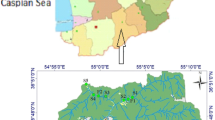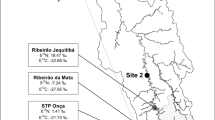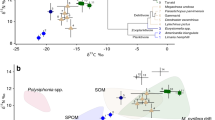Abstract
A pilot study was conducted to assess the potential for stable isotope analyses to reveal the fate of waste pelleted food material from fish farms in freshwater food webs. Esthwaite Water (Cumbria, UK) was selected as the study site, as it hosts an established salmonid farm, and a wealth of complementary limnological data exists. Salmonid pellet feed consists of primarily marine-derived material and thus exhibits carbon and nitrogen stable isotopic compositions distinct to most freshwater organic material. Comparison of the isotopic ratios of organisms at the cage site with an unaffected control site, supports incorporation of pellet-derived material to the diet of planktonic and benthic communities. Moreover, after allowing for a number of trophic transfers, stable isotope analyses revealed the predatory cladoceran Leptodora kindti also utilised pellet material, while roach were probably short-circuiting the food chain by directly consuming particulate pellet material, as well as via ingestion of their zooplankton prey. Isotope data substituted into a simple two-source mixing model suggested that approximately 65% of Daphnia, and >80% of roach body carbon may be derived from pellet material in the plankton, and that chironomid larvae may incorporate >50% in the sediment environs. However, contributions calculated from both δ 13C and δ 15N values were inconsistent, which may simply be due to the constraints of the model and parameters used, but may also reflect different routing of isotopes from the original pellet source, via soluble or particulate routes.
Similar content being viewed by others
References
Adams, T. S. & R. W. Sterner, 2000. The effect of dietary nitrogen content on trophic level enrichment. Limnology and Oceanography 45: 601-607.
DeMott, W. R., 1988. Discrimination between algae and arti-ficial particles by freshwater and marine copepods. Limnology and Oceanography 33: 397-408.
Feuchtmayr, H. & J. Grey, 2003. Effect of preparation and preservation procedures on carbon and nitrogen stable isotope determinations from zooplankton. Rapid Communications in Mass Spectrometry 17: 2605-2610.
Fry, B., 2002. Stable isotopic indicators of habitat use by Mississippi river fish. Journal of the North American Benthological Society 21: 676-685.
Gannes, L. Z., D. M. O'Brien & C. Martí;nez del Rio, 1997. Stable isotopes in animal ecology: assumptions, caveats and a call for more laboratory experiments. Ecology 78: 1271-1276.
George, D. G., 1993. Physical and chemical scales of pattern in freshwater lakes and reservoirs. The Science of the Total Environment 135, 1-15.
Goedkoop, W., L. Sonesten, H. Markensten & G. Ahlgren, 1998. Fatty acid biomarkers show dietary differences between dominant chironomid taxa in Lake Erken. Freshwater Biology 40: 135-143.
Gowen, R. J. & N. B. Bradbury, 1987. The ecological impact of salmonid farming in coastal waters: a review. Oceanography and Marine Biology 25: 563-575.
Grey, J., 2000. Trophic fractionation and the effects of diet switch on the carbon stable isotopic 'signatures' of pelagic consumers. Verhandlungen der Internationalen Vereinigung fú;r Theoretische und Angewandte Limnologie 27: 3187-3191.
Grey, J., 2002. Cracking a chironomid conundrum: queries arising from stable isotope analysis. Verhandlungen der Internationalen Vereinigung fü r Theoretische und Angewandte Limnologie 28: 102-105.
Grey, J., R. I. Jones & D. Sleep, 2001. Seasonal changes in the importance of allochthonous organic matter to the diet of zooplankton in Loch Ness indicated by stable isotope analysis. Limnology and Oceanography 46: 505-513.
Grey, J., A. Kelly & R. I. Jones, 2004. High intraspecific variability in carbon and nitrogen stable isotope ratios of lake chironomid larvae. Limnology and Oceanography 49: 239-244.
Hall, P. O. J., O. Holby, S. Kollberg & M.-O. Samuelsson, 1992. Chemical fluxes and mass balances in a marine fish cage farm. IV. Nitrogen. Marine Ecology Progress Series 89:81-91.
Hall, G. H., J. E. Corry & J. P. Lishman, 1993. The surface water quality of Esthwaite Water in response to a reduction of the phosphate load from Hawkshead Sewage Treatment Works. The potential of external and internal phosphorus loads to prevent lake restoration. Institute of Freshwater Ecology Report for the National Rivers Authority, Windermere.
Harvey, C. J., P. C. Hanson, T. E. Essington, P. B. Brown & J. F. Kitchell, 2002. Using bioenergetics models to predict stable isotope ratios in fishes. Canadian Journal of Fisheries and Aquatic Sciences 59: 115-124.
Heaney, S. I., W. J. P. Smyly & J. F. Talling, 1986. Interactions of physical, chemical and biological processes in depth and time within a productive English lake during summer stratification. Internationale Revue der Gesamten Hydrobiologie 71: 441-494.
Hornibrook, E. R. C., F. J. Longstaffe & W. S. Fyfe, 2000. Factors influencing stable isotope ratios in CH4 and CO2 within subenvironments of freshwater wetlands: implications for delta signatures of emissions. Isotopes in Environmental and Health Studies 36: 151-176.
Johnson, R. K., 1987. Seasonal variation in diet of Chironomus plumosus (L.) and C. anthracinus Zett (Diptera: Chironomidae) in mesotrophic Lake Erken. Freshwater Biology 17: 525-532.
Jones, A. B., M. J. O'Donohue, J. Udy & W. C. Dennison, 2001. Assessing ecological impacts of shrimp and sewage effluent: biological indicators with standard water quality analyses. Estuarine, Coastal and Shelf Science 52: 91-109.
Jones, J. G., 1990. Pollution from fish farms. Journal of the Institution of Water and Environmental Management 4: 14-18.
Jones, J. I. & S. Waldron, 2003. Combined stable isotope and gut contents analysis of food webs in plant-dominated, shallow lakes. Freshwater Biology 48: 1396-1407.
Kibria, G., D. Nugegoda, R. Fairclough & P. Lam, 1997. The nutrient content and the release of nutrients from fish food and faeces. Hydrobiologia 357: 165-171.
Maberly, S. C., 1996. Diel, episodic and seasonal changes in pH and concentrations of inorganic carbon in a productive lake. Freshwater Biology 35: 579-598.
McGhie, T. K., C. M. Crawford, I. M. Mitchell & D. O'Brien, 2000. The degradation of fish-cage waste in sediments during fallowing. Aquaculture 187: 351-366.
Merican, Z. O. & M. J. Phillips, 1985. Solid waste production from rainbow trout, Salmo gairdneri Richardson, cage culture. Aquaculture and Fisheries Management 1: 55-69.
Minagawa, M. & E. Wada, 1984. Stepwise enrichment of 15N along food chains: further evidence and the relation between d15N and animal age. Geochimica Cosmochimica Acta 48: 1135-1140.
Peterson, B. J. & B. Fry, 1987. Stable isotopes in ecosystem studies. Annual Review of Ecology and Systematics 18: 293-320.
Phillips, D. L., 2001. Mixing models in analyses of diet using multiple stable isotopes: a critique. Oecologia 127: 166-170.
Phillips, D. L. & J. W. Gregg, 2001. Uncertainty in source partitioning using stable isotopes. Oecologia 127: 171-179.
Phillips, M. J., M. C. M. Beveridge & J. F. Muir, 1985. Waste output and environmental effects of rainbow trout cage culture. International Council for the Exploration of the Sea CM 1985/F: 21.
Post, D. M., 2002. Using stable isotopes to estimate trophic position: models, methods and assumptions. Ecology 83: 703-718.
Steele, K. W. & R. M. Daniel, 1978.Fractionation of nitrogen isotopes by animals: a further complication to the use of variations in the natural abundance of for tracer studies. Journal of Agricultural Science 90: 7-9.
Talling, J. F. (ed.), 1999. Some English lakes as diverse and active ecosystems: a factual summary and source book. Freshwater Biological Association, Ambleside.
Waldron, S., P. Tatner, I. Jack & C. Arnott, 2001. The impact of sewage discharge into a marine embayment: a stable isotope reconnaissance. Estuarine, Coastal and Shelf Science 52: 111-115.
Weston, D. P., 1990. Quantitative examination of macrobenthic community changes along an organic enrichment gradient. Marine Ecology Progress Series 61: 233-24
Ye, L.-X., D. A. Ritz, G. E. Fenton & M. E. Lewis, 1991. Tracing the influence on sediments of organic waste from a salmonid farm using stable isotope analysis. Journal of Experimental Marine Biology and Ecology 145: 161-174.
Yokoyama, H., J. Higano, K. Adachi, Y. Ishihi, Y. Yamada & P. Pichitkul, 2002. Evaluation of shrimp polyculture system in Thailand based on stable carbon and nitrogen isotope ratios. Fisheries Science 68: 745-750.
Author information
Authors and Affiliations
Rights and permissions
About this article
Cite this article
Grey, J., Waldron, S. & Hutchinson, R. The Utility of Carbon and Nitrogen Isotope Analyses to Trace Contributions from Fish Farms to the Receiving Communities of Freshwater Lakes: a Pilot Study in Esthwaite Water, UK. Hydrobiologia 524, 253–262 (2004). https://doi.org/10.1023/B:HYDR.0000036144.49795.dd
Issue Date:
DOI: https://doi.org/10.1023/B:HYDR.0000036144.49795.dd




